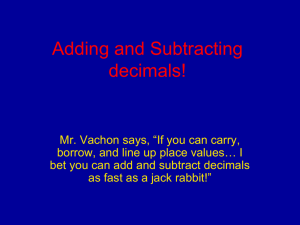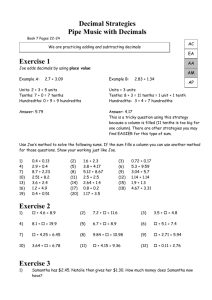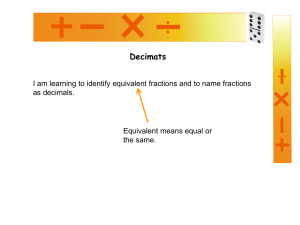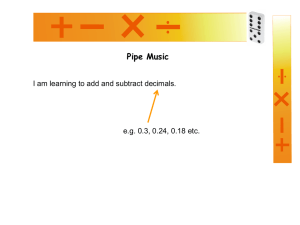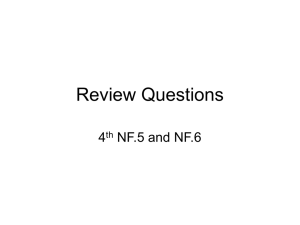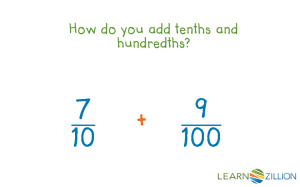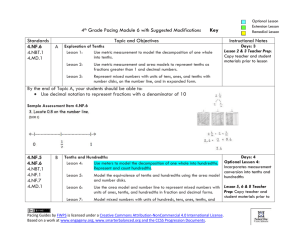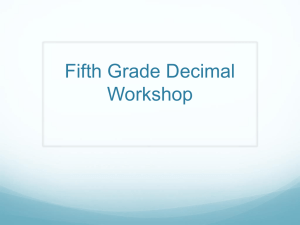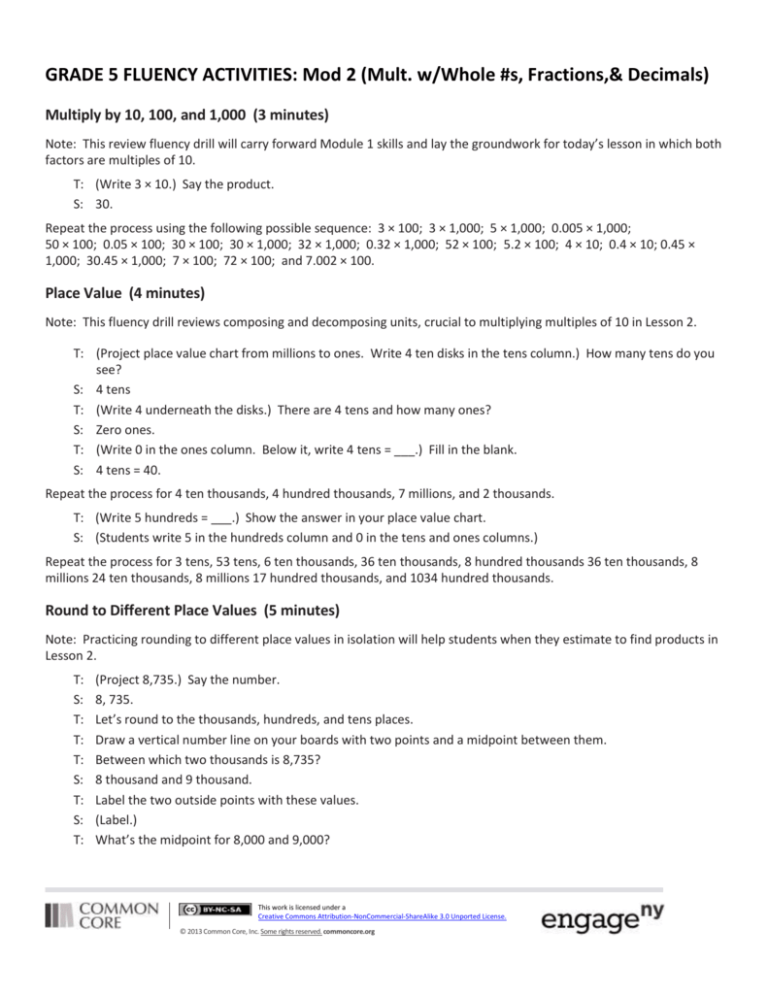
GRADE 5 FLUENCY ACTIVITIES: Mod 2 (Mult. w/Whole #s, Fractions,& Decimals)
Multiply by 10, 100, and 1,000 (3 minutes)
Note: This review fluency drill will carry forward Module 1 skills and lay the groundwork for today’s lesson in which both
factors are multiples of 10.
T: (Write 3 × 10.) Say the product.
S: 30.
Repeat the process using the following possible sequence: 3 × 100; 3 × 1,000; 5 × 1,000; 0.005 × 1,000;
50 × 100; 0.05 × 100; 30 × 100; 30 × 1,000; 32 × 1,000; 0.32 × 1,000; 52 × 100; 5.2 × 100; 4 × 10; 0.4 × 10; 0.45 ×
1,000; 30.45 × 1,000; 7 × 100; 72 × 100; and 7.002 × 100.
Place Value (4 minutes)
Note: This fluency drill reviews composing and decomposing units, crucial to multiplying multiples of 10 in Lesson 2.
T: (Project place value chart from millions to ones. Write 4 ten disks in the tens column.) How many tens do you
see?
S: 4 tens
T: (Write 4 underneath the disks.) There are 4 tens and how many ones?
S: Zero ones.
T: (Write 0 in the ones column. Below it, write 4 tens = ___.) Fill in the blank.
S: 4 tens = 40.
Repeat the process for 4 ten thousands, 4 hundred thousands, 7 millions, and 2 thousands.
T: (Write 5 hundreds = ___.) Show the answer in your place value chart.
S: (Students write 5 in the hundreds column and 0 in the tens and ones columns.)
Repeat the process for 3 tens, 53 tens, 6 ten thousands, 36 ten thousands, 8 hundred thousands 36 ten thousands, 8
millions 24 ten thousands, 8 millions 17 hundred thousands, and 1034 hundred thousands.
Round to Different Place Values (5 minutes)
Note: Practicing rounding to different place values in isolation will help students when they estimate to find products in
Lesson 2.
T:
S:
T:
T:
T:
S:
T:
S:
T:
(Project 8,735.) Say the number.
8, 735.
Let’s round to the thousands, hundreds, and tens places.
Draw a vertical number line on your boards with two points and a midpoint between them.
Between which two thousands is 8,735?
8 thousand and 9 thousand.
Label the two outside points with these values.
(Label.)
What’s the midpoint for 8,000 and 9,000?
This work is licensed under a
Creative Commons Attribution-NonCommercial-ShareAlike 3.0 Unported License.
© 2013 Common Core, Inc. Some rights reserved. commoncore.org
S: 8,500.
T: Label your number line. 8,500 is the same as how many hundreds?
S: 85 hundreds.
T: How many hundreds are in 8,735?
S: 87 hundreds.
T: (Write 8,735 ≈ _______.) Show 8,735 on your number line and write the number sentence.
S: (Label 8,735 between 8,500 and 9,000 on the number line, and write 8,735 ≈ 9,000.
Students round to the hundreds and tens. Follow the same process and procedure for 7,458
Round to Different Place Values (2 minutes)
Note: Practicing rounding to different place values in isolation will help students when they estimate to find products
later in the module.
T:
(Project 48,625.) Say the number.
S:
48,625.
T:
(Write a vertical number line with two points and a midpoint.) Between which two ten-thousands is
48,625?
S:
40,000 and 50,000.
T:
(Write 40,000 at the bottom point and 50,000 at the top point.) What’s the midpoint for 40,000 and
50,000?
S:
45,000.
T:
(Write 45,000 at the midpoint.) Would 48,625 fall above or below 45,000?
S:
T:
S:
Above.
(Write 48,625 ≈ _______.) What’s 48,625 rounded to the nearest ten-thousand?
50,000.
Repeat the process for thousands, hundreds, and tens.
Multiply by Multiples of 10 (2 minutes)
Note: This review fluency drill will help preserve skills students learned
and mastered in Module 1 and lay the groundwork for future concepts.
T:
(Write 31 × 10 =
.) Say the multiplication
sentence.
S:
31 × 10 = 310.
T:
(Write 310 × 2 =
beside 31 × 10 = 310.) Say the
multiplication sentence.
S:
310 × 2 = 620.
T:
(Write 310 × 20 =
below 310 × 2 = 620.) Write 310 × 20 as a three-step multiplication sentence,
taking out the ten.
S:
310 × 10 × 2 = 6,200.
T:
Show your board. (Check for accuracy.)
Direct students to solve using the same method for 23 × 40 and 32 × 30.
This work is licensed under a
Creative Commons Attribution-NonCommercial-ShareAlike 3.0 Unported License.
© 2013 Common Core, Inc. Some rights reserved. commoncore.org
Estimate Products (5 minutes)
T:
(Write 421 × 18 ≈ ____ × ___ = ___.) Round 421 to the nearest hundred.
S:
400.
T:
(Write 421 × 18 ≈ 400 × ___ = ___.) Round 18 to the nearest ten.
S:
20.
T:
(Write 421 × 18 ≈ 400 × 20 = ___.) What’s 400 × 20?
S:
8,000.
T:
(Write 421 × 18 ≈ 400 × 20 = 8,000.)
T:
(Write 323 × 21 ≈ ____ × ___ = ___.) On your boards, write the multiplication sentence rounding each
factor to arrive at a reasonable estimate of the product
S:
(Write 323 × 21 ≈300 × 20 = 6,000.)
Repeat the process and procedure for 1,950 × 42 and 2,480 × 27. Teacher may choose to ask for students to explain the
reasoning behind their estimates.
Decompose a Factor: The Distributive Property (4 minutes)
Note: Reviewing multiplication decomposition with low numbers will prepare students for decomposing multiplication
sentences with bigger numbers in upcoming lessons. Students might be allowed to generate their own decomposition
to be used in the distribution (e.g., for the first, possible decompositions of 9 include 2 and 7 or 3 and 6). However, this
will increase the time necessary for this fluency activity.
T:
(Write 9 × 3 =___.) Write the multiplication sentence.
S:
(Write.)
T:
(Write (5 × 3) + ( __ × 3) = ____ below 9 × 3 =___.) 9 is the same as 5 and what number?
S:
4.
T:
(Write (5 × 3) + (4 × 3) = ___. Below it, write 15 + ____ = ____.) Fill in the blanks.
S:
(Write 9 × 3 = 27. Below it, write (5 × 3) + (4 × 3) = 27. Below that line, write
15 + 12 = 27.)
Repeat using the following possible sequence of 7 × 4, 8 × 2, and 9 × 6.
Estimate Products (4 minutes)
T:
(Write 409 × 21 ≈ ____ × ___ = ___.) On your boards, write the multiplication sentence rounding each
factor to arrive at a reasonable estimate of the product.
S:
(Write 409 × 21 ≈ 400 × 20 = 8,000.)
Repeat the process and procedure for 287 × 64; 3,875 × 92; and 6,130 × 37.
Decompose Multiplication Sentences (4 minutes)
T:
S:
T:
S:
(Write 12 × 3 = ___.) Write the multiplication sentence.
(Write.)
(Write (8 × 3) + ( __ × 3) = ___ below 12 × 3 = ___.) 12 is the same as 8 and what number?
4.
This work is licensed under a
Creative Commons Attribution-NonCommercial-ShareAlike 3.0 Unported License.
© 2013 Common Core, Inc. Some rights reserved. commoncore.org
NOTES ON
MULTIPLE MEANS OF
REPRESENTATION:
T:
S:
(Write (8 × 3) + (4 × 3) = ___. Below it, write 24 + ____ = ____.) Fill in the blanks.
(Write 12 × 3 = 36. Below it, they write (8 × 3) + (4 × 3) = 36. Below that line, they write 24 + 12 = 36.)
Repeat using the following possible sequence: 14 × 4, 13 × 3, and 15 × 6, changing the missing numbers that students
need to fill in.
Write the Value of the Expression (4 minutes)
T:
(On the board, write 11 × (15 + 5).) Write the expression as a single multiplication sentence without
brackets.
S:
(Write 11 × 20 = 220.)
Repeat the process for (41 – 11) × 12, (75 + 25) × 38, and (20 × 2) + (6 × 2).
Multiply Mentally (4 minutes)
Notes: This fluency drill will help bolster the students’ understanding of
and automaticity with the distributive property of multiplication.
T:
(Write 9 × 10 =.) Say the multiplication sentence.
S:
9 × 10 = 90.
T:
(Write 9 × 9 = 90 – ____ below 9 × 10 =.) On your personal
boards, write the number sentence, filling in the blank.
S:
(Students write 9 × 9 = 90 – 9.)
T:
What’s 9 × 9?
S:
81.
Repeat the process and procedure for 9 × 100, 9 × 99, 15 × 10, 15 × 9, 29 × 100, and 29 × 99
Multiply by Multiples of 100 (4 minutes)
Notes: This review fluency drill will help preserve skills students learned and mastered in Module 1 and lay the
groundwork for future concepts.
T:
(Write 31 × 100 = _____.) Say the multiplication sentence.
S:
31 × 100 = 3,100.
T:
(Write 3,100 × 2 = _____ below 31 × 100 = 3,100.) Say the multiplication sentence.
S:
3,100 × 2 = 6,200.
T:
(Write 31 × 200 = _____ below 3,100 × 2 = 6,200.) Say 31 × 200 as a three-step multiplication sentence,
taking out the hundred.
S:
31 × 100 × 2 = 6,200.
T:
(Write 31 × 200 = 6,200.)
Direct students to solve using the same method for 24 × 300 and 34 × 200.
Multiply Mentally (4 minutes)
Materials: (S) Mental Multiplication Pattern Sheet
This work is licensed under a
Creative Commons Attribution-NonCommercial-ShareAlike 3.0 Unported License.
© 2013 Common Core, Inc. Some rights reserved. commoncore.org
Note: This fluency drill will help bolster the students’ understanding of and automaticity with the distributive property
of multiplication.
Distribute the Mental Multiplication pattern sheet and give students two minutes to do as many problems as they can.
Probe the room correcting misunderstandings and encouraging students to use mental math strategies.
Multiply Using the Area Model (4 minutes)
T:
S:
T:
S:
T:
S:
(Write 43 × 12 =____.) Draw an area model on your personal board to solve.
(Students write 43 × 12 = ____.)
Fill in your area model and number sentence.
(Write: 43 × 12 = 516.)
Solve using the algorithm.
(Solve.)
Repeat the procedure using the following sequence: 243 × 12 and 312 × 23.
State in Exponential Form (3 minutes)
Note: This maintains earlier skills and encourages insights into the place value structure of multi-digit multiplication’s
partial products. A quick review of relevant vocabulary (base, exponent, power) may be in order.
T:
S:
T:
S:
T:
S:
T:
S:
(Write 102 =
.) Say the base.
10.
Say the exponent.
2.
Say 10 squared as a multiplication sentence starting with 10.
10 × 10 = 100.
Say it as a number sentence without using a multiplication sentence.
10 squared equals 100.
Repeat the process with 103, 104, 105, and 107
Multiply Using the Area Model with a Zero in One Factor (4 minutes)
Note: As mentioned in Lesson 7, students will need additional practice when there is a zero in one of the factors. If
deemed appropriate, students may be asked to share their observations about what they notice in these cases and then
justify their thinking.
Follow the same process and procedure as G5–M2–Lesson 7, juxtaposing similar problems such as 342 × 251 and 342 ×
201 whereby one factor has a zero.
Multiply and Divide by Exponents (4 minutes)
Note: This review fluency drill will encourage flexible thinking because of the inclusion of division. The notation of the
This work is licensed under a
Creative Commons Attribution-NonCommercial-ShareAlike 3.0 Unported License.
© 2013 Common Core, Inc. Some rights reserved. commoncore.org
exponent form is also important to revisit and reuse so that it becomes natural to the students to think of powers of 10
written either as multiples of 10 or as exponents.
T:
S:
T:
S:
T:
S:
(Project place value chart from millions to thousandths.) Write 45 tenths as a decimal.
(Write 4 in the ones column and 5 in the tenths column.)
Say the decimal.
4.5.
Multiply it by 102.
(Cross out 4.5 and write 450.)
Repeat the process and sequence for 0.4 × 102, 0.4 ÷ 102, 3.895 × 103, and 5,472 ÷ 103.
Estimate the Product (6 minutes)
Note: Just before beginning the lesson, estimating reminds students to apply this during the lesson.
T:
S:
T:
S:
(Write 412 × 231 ≈ ____ × ___.) Round both factors to the nearest hundred.
400 × 200
Write 412 × 231≈ 400 × 200. What is 400 × 200?
80,000.
Repeat the process and procedure for 523 × 298 ≈ 500 × 300, 684 × 347, and 908 × 297.
Multiply then Divide by the Same Number (6 minutes)
Note: This fluency drill reviews what happens when any number or expression is divided and then multiplied by the
same number in preparation for today's lesson.
T:
3 × 2 is?
S:
6.
T:
3 × 2 × 10 ÷ 10 is?
S:
6.
T:
5 × 0.3 is?
S:
1.5
T:
5 × 0.3 × 10 ÷ 10 is?
S:
1.5.
T:
(Continue the sequence with 3 × 2.5 and 2 × 3.4.)
T:
Why are the products the same when we multiply by 10 and then divide by 10?
S:
You are undoing what you did when you multiplied by 10. We’re moving over one place to the left
on the place value chart and then back to the right again. Because, it’s just like multiplying by 1
This work is licensed under a
Creative Commons Attribution-NonCommercial-ShareAlike 3.0 Unported License.
© 2013 Common Core, Inc. Some rights reserved. commoncore.org
Decompose Decimals (6 minutes)
Note: This fluency drill reviews decimal place value concepts and
emphasizes part–whole decomposition through the use of the
number bond.
T:
(Project 7.463.) Say the number.
S:
7 and 463 thousandths.
T: Represent this number in a two-part number bond with
ones as one part and thousandths as the other part
(pictured to the right).
S:
(Draw.)
T:
Represent it again with tenths and thousandths.
T:
Represent it again with hundredths and
thousandths.
Follow the same process for 8.972 and 6.849
Multiply then Divide by the Same Number (4 minutes)
Note: This fluency drill reviews what happens when any number or expression is divided and then multiplied by the
same number in preparation for today's lesson.
T:
S:
T:
S:
T:
S:
T:
T:
S:
T:
3 × 4.1 is?
12.3.
12.3 × 10 ÷ 10 is?
12.3.
3 × 4.1 × 1 is?
12.3.
(Repeat with 3 × 2.4.)
3 × 4 × 17.6 ÷ 17.6 is?
12.
Discuss how you know that is true with your partner.
Unit Conversions (5 minutes)
Note: Reviewing this fluency will build a foundation for upcoming Topic D lessons on measurement problem solving.
T:
S:
(Write 12 in = ___ ft.) 12 inches is the same as how many feet?
1 foot.
Repeat the process for possible sequence: 24 in, 36 in, 48 in, and 120 in.
T:
S:
(Write 1 ft = ___ in.) 1 foot is the same as how many inches?
12 inches.
Repeat the process and procedure for 2 ft, 2.5 ft, 3 ft, 3.5 ft, 4 ft 4.5 ft 9 ft, 9.5 ft 27 ft, and 27.5 ft.
State the Decimal (5 minutes)
This work is licensed under a
Creative Commons Attribution-NonCommercial-ShareAlike 3.0 Unported License.
© 2013 Common Core, Inc. Some rights reserved. commoncore.org
Note: This fluency drill will review concepts learned in Module 1.
T:
S:
Say the number as a decimal. 8 tenths.
Zero point eight.
Repeat process using the following possible sequence: 9 tenths, 10 tenths, 11 tenths, 19 tenths, 20 tenths, 30 tenths, 35
tenths, 45 tenths, 85 tenths, 83 tenths, 63 tenths, and 47 tenths.
T:
S:
Say the number as a decimal. 8 hundredths.
Zero point zero eight.
Repeat the process for the following possible sequence: 9 hundredths, 10 hundredths, 20 hundredths, 30 hundredths,
90 hundredths, 95 hundredths, 99 hundredths, 199 hundredths, 299 hundredths, 257 hundredths, and 463 hundredths.
Divide by 10, 100, and 1,000 (2 minutes)
Note: This fluency drill will prepare students to use divide by 10 patterns for multi-digit whole numbers in Lesson 16
T:
S:
(Write 30 ÷ 10 =______.) Say the answer.
3.
Repeat the process for the following possible sequence: 300 ÷ 100; 3,000 ÷ 1,000; 5,000 ÷ 1,000; 50 ÷ 10; 500 ÷ 100;
5,000 ÷ 100; 3,000 ÷ 100; 30,000 ÷ 1,000; 50,000 ÷ 1,000; 40 ÷ 10, 400 ÷ 10; 4,000 ÷ 10;
40,000 ÷ 10; 700 ÷ 100; 7,000 ÷ 100; 70,000 ÷ 100; 700,000 ÷ 100; 7,000,000 ÷ 1,000.
Multiply Using the Area Model (7 minutes)
Follow the same process and procedure as G5–M2–Lessons 11 and 12 for the following possible sequence: 5.21 × 34
and 8.35 × 73.
Unit Conversions (3 minutes)
Note: Reviewing this fluency will build a foundation for upcoming Module 2 lessons.
T:
S:
(Write 1 ft = ___ in.) 1 foot is the same as how many inches?
12 inches.
Repeat the process for the following possible sequence: 2 ft, 3 ft, 4 ft, 10 ft, 5 ft, 7 ft.
T:
S:
(Write 100 cm = ___ m.) 100 centimeters is the same as how many meters?
1 meter.
Repeat the process and procedure for 200 cm, 300 cm, 600 cm, 800 cm, 400 cm.
Divide by Multiples of 10 (3 minutes)
Note: This review fluency drill will prepare students to approximate quotients with two-digit divisors in Lesson 17.
T:
(Write 420 ÷ 10 =
S:
420 ÷ 10 = 42.
T:
(Write 42 ÷ 2 =
the division sentence.
.) Say the division sentence.
below 420 ÷ 10 = 42.) Say
420 ÷ 10 = 42
42 ÷ 2 = 21
420 ÷ 20 = 21
10
This work is licensed under a
Creative Commons Attribution-NonCommercial-ShareAlike 3.0 Unported License.
© 2013 Common Core, Inc. Some rights reserved. commoncore.org
÷
2
S:
42 ÷ 2 = 21.
T:
(Write 420 ÷ 20 =
below 42 ÷ 2 = 21.) Say
420 ÷ 20 as a three-step division sentence, taking out the
ten.
S:
420 ÷ 10 ÷ 2 = 21.
T:
(Write 420 ÷ 20 = 21.)
Direct students to solve using the same method for 960 ÷ 30 and 680 ÷ 20.
Unit Conversions (6 minutes)
T:
S:
T:
S:
1 meter is how many centimeters?
100 centimeters.
(Write 1 m 50 cm = ___ cm.) 1 meter and 50 centimeters is the same as how many centimeters?
150 centimeters.
Repeat the process for the following possible sequence: 1 m 5 cm, 2 m, 2 m 30 cm, 2 m 70 cm, 2 m 7 cm, 2 m 90 cm, 4
m 8 cm.
T:
S:
T:
S:
1 foot is the same as how many inches?
12 inches.
(Write 1 ft 1 in = ___ in.) On your boards, write the conversion.
(Write 1 ft 1 in = 13 in.)
Repeat the process for the following possible sequence: 1 ft 2 in, 1 ft 3 in, 1 ft 10 in, 1 ft 8 in, 2 ft, 2 ft 1 in, 2 ft 10 in, 2 ft
6 in, 3 ft, 3 ft 10 in, 3 ft 4 in.
T:
S:
T:
S:
12 inches is the same as what single unit.
1 foot.
(Write 13 in = ___ ft ___ in.) On your boards, write the conversion.
(Students write 13 in = 1 ft ___ in.)
Repeat the process for the following possible sequence: 14 in, 22 in, 24 in, 34 in, 25 in, 36 in, 46 in, 40 in, 48 in, 47 in, 49
in, 58 in.
Decompose Decimals (3 minutes)
Note: This fluency drill will review concepts learned in Module 1 and help students apply their place value
understanding to decimal division in the latter topics of the module.
T:
(Project 3.184.) Say the number.
S:
3 and 184 thousandths.
T:
How many tenths are in 3.184?
S:
31 tenths.
T:
(Write 3.184 = 31 tenths ____ hundredths.) On your boards, write the number, taking out the tenths.
S:
(Write 3.184= 31 tenths 84 hundredths.)
Repeat the process for hundredths. Follow the same process for 6.723 and 9.246.
Round to the Nearest Ten (2 minutes)
This work is licensed under a
Creative Commons Attribution-NonCommercial-ShareAlike 3.0 Unported License.
© 2013 Common Core, Inc. Some rights reserved. commoncore.org
Note: Rounding to the nearest ten will prepare students to estimate quotients.
T:
S:
(Write 32 ≈ ___.) What’s 32 rounded to the nearest ten?
30.
Repeat the process for 47, 18, 52, 74, 85, and 15.
Group Count by Multiples of 10 (3 minutes)
Note: Counting by multiples of 10 will prepare students for G5–M2–Lesson 17’s Concept Development.
T:
S:
T:
S:
T:
S:
Count by threes.
3, 6, 9, 12, 15, 18, 21, 24, 27, 30.
Count by 3 tens. When I raise my hand stop counting.
3 tens, 6 tens, 9 tens.
(Raise hand.) Say 9 tens in standard form.
90.
Continue the process, stopping at 15 tens, 24 tens, and 30 tens.
Repeat the process with 6 tens, stopping periodically.
Divide by Multiples of 10, 100, and 1,000 (5 minutes)
Note: This drill reviews content from G5–M2–Lesson 16.
T:
S:
T:
S:
T:
S:
T:
S:
(Write 700 ÷ 10.) Say the division sentence.
700 ÷ 10 = 70.
(Write 800 ÷ 20.) Write 800 ÷ 20 as a two-step division sentence taking out the ten.
(Write = 800 ÷ 10 ÷ 2.)
Below the two-step division sentence, rewrite it in one step after solving the first division problem.
(Write = 80 ÷ 2.)
Write the answer below 80 ÷ 2.
(Write = 40.)
Repeat the process for the following possible sequence: 15,000 ÷ 30, 15,000 ÷ 300, 15,000 ÷ 3,000, 450,000 ÷ 50, and
21,000 ÷ 300.
Estimate and Divide (4 minutes)
Notes: This drill will review content from G5–M2–Lesson 17.
T:
S:
T:
S:
T:
(Write 812 ÷ 39.) Say the divisor rounded to the nearest ten.
40.
Name the multiple of 40 that’s closest to 812.
800.
On your boards, write a division problem that will estimate the value.
This work is licensed under a
Creative Commons Attribution-NonCommercial-ShareAlike 3.0 Unported License.
© 2013 Common Core, Inc. Some rights reserved. commoncore.org
S:
T:
S:
(Write ≈ 800 ÷ 40.)
Below 800 ÷ 40, write the answer.
(Write = 20.)
Repeat the process for the following possible sequence: 183 ÷ 31; 437 ÷ 72; 823 ÷ 97; 8,191 ÷ 92.
Divide by Multiples of Ten with Remainders (5 minutes)
Note: This drill reviews G5–M2–Lesson 19 content.
T:
(Write 73 ÷ 50.) On your boards, solve the division problem using the standard algorithm. Check your
work using multiplication and addition.
Repeat process for 70 ÷ 30, 157 ÷ 30, and 432 ÷ 70.
Divide by Two-Digit Numbers (7 minutes)
Notes: This drill reviews G5–M2–Lesson 20 content.
T:
(Write 61 ÷ 17.) On your boards, show me how to estimate the quotient.
S:
(Write 60 ÷ 20 = 3)
T:
Solve the equation.
S:
(Solve and check as exemplified to the right.)
Repeat the process using the following possible sequence: 48 ÷ 21, 99 ÷ 32, and 74 ÷ 37.
Divide Decimals (3 minutes)
Note: This drill prepares students for G5–M2–Lesson 24’s Concept Development.
T:
S:
(Write 6 hundreds ÷ 2 =.) Say the division sentence in unit form.
6 hundreds ÷ 2 = 3 hundreds.
Repeat process with 6 tens ÷ 2 and 6 ones ÷ 2, and 6 tenths ÷ 2.
T:
S:
On your boards, write 6 tenths ÷ 2 in decimal form.
(Write 0.6 ÷ 2 = 0.3.)
Repeat the process for 6 hundredths ÷ 2, 8 thousands ÷ 2, 8 ones ÷ 2, 8 tenths ÷ 2, and 8 hundredths ÷ 2.
Rename Tenths and Hundredths (4 minutes)
Note: This drill will prepare students for estimating decimal quotients in G5–M2–Lesson 25.
T:
S:
I’ll say a number, and you state it as a decimal. 1 tenth.
0.1.
Repeat the process for 2 tenths, 3 tenths, 8 tenths, and 9 tenths.
T:
S:
(Write 10 tenths =.) Write the number.
(Write 1.)
Repeat the process for 11 tenths, 19 tenths, 20 tenths, 30 tenths, 80 tenths, 90 tenths, 100 tenths, and 200 tenths.
Repeat the process for 1 hundredth, 2 hundredths, 3 hundredths, 8 hundredths, 9 hundredths, 10 hundredths, 20
This work is licensed under a
Creative Commons Attribution-NonCommercial-ShareAlike 3.0 Unported License.
© 2013 Common Core, Inc. Some rights reserved. commoncore.org
hundredths, 30 hundredths, 90 hundredths, 100 hundredths, 200 hundredths, 900 hundredths, 1,000 hundredths, and
2,000 hundredths.
Rename Tenths and Hundredths (4 minutes)
Note: This drill prepares students for estimating decimal quotients in G5–M2–Lesson 25.
Repeat the process from G5–M2–Lesson 23 using the following possible sequence: 9 tenths, 10 tenths, 20 tenths, 90
tenths, 95 tenths, 100 tenths, 200 tenths, 600 tenths, 650 tenths, 657 tenths, 832 tenths, 9 hundredths, 10 hundredths,
20 hundredths, 90 hundredths, 95 hundredths, 100 hundredths, 200 hundredths, 900 hundredths, 950 hundredths,
1,000 hundredths, 2,000 hundredths; 5,000 hundredths, 5,800 hundredths, 5,830 hundredths, 5,834 hundredths, and
2,834 hundredths.
Divide Decimals (3 minutes)
Note: This drill prepares students for Content Development in G5–M2–Lesson 24.
Repeat the process from G5–M2–Lessons 22 and 23 using the following possible sequence: 15 ones ÷ 5, 15
tenths ÷ 5, 15 hundredths ÷ 5, 12 tens ÷ 3, 12 tenths ÷ 3, 24 hundreds ÷ 6, and 24 hundredths ÷ 6.
Rename Tenths and Hundredths (4 minutes)
Note: This drill prepares students for estimating decimal quotients during the Concept Development.
Repeat the process from G5–M2–Lessons 23 and 24 for the following possible sequence: 10 tenths, 90 tenths, 94
tenths, 100 tenths, 700 tenths, 783 tenths, 372 tenths, 9 hundredths, 10 hundredths, 90 hundredths, 98 hundredths,
100 hundredths, 900 hundredths, 980 hundredths, 1,000 hundredths, 7,000 hundredths, 7,400 hundredths, 7,418
hundredths, and 4,835 hundredths.
Divide Decimals by 10 (4 minutes)
Note: This drill reviews G5–M2–Lesson 24 content.
T:
(Project 3,800 on a place value chart. To the side, write 3,800 ÷ 10.) Say the division sentence.
S:
3,800 ÷ 10 = 380.
T: (Cross out each digit and draw arrows one place value to the right. Write 380 in the place value chart.) When
dividing by 10, digits shift how many places to the right?
S:
One.
T:
(Project 380 on a place value chart. To the side, write 380 ÷ 10.) On your boards, write the division sentence
and answer.
S:
(Write 380 ÷ 10 = 38.)
Repeat the process for 38 ÷ 10; 3.8 ÷ 10; 270 ÷ 10; 2.7 ÷ 10; 4,900 ÷ 10; 49 ÷ 10; and 0.49 ÷ 10.
Divide Decimals by Multiples of 10 (4 minutes)
Note: This drill reviews G5–M2–Lesson 24 content.
T:
(Write 1.2 ÷ 4 =.) Solve the division equation expressing the whole in tenths.
This work is licensed under a
Creative Commons Attribution-NonCommercial-ShareAlike 3.0 Unported License.
© 2013 Common Core, Inc. Some rights reserved. commoncore.org
S:
T:
12 tenths ÷ 4 = 3 tenths.
(Write 1.2 ÷ 4 = 0.3. To the right, write 1.2 ÷ 40 =.) On your boards, write 12 tenths ÷ 40 as a three-step
division sentence, taking out the ten.
S: (Write (1.2 ÷ 10) ÷ 4 = 0.12 ÷ 4 = 0.03.)
NOTES ON
Repeat the process for 2.4 ÷ 2, 2.4 ÷ 20, 8 ÷ 2, 8 ÷ 20, 0.35 ÷ 5, and 0.35 ÷ 50.
MULTIPLE MEANS OF
REPRESENTATION:
Rename Tenths and Hundredths (4 minutes)
Note: This drill prepares students for estimating decimal quotients during the
Concept Development.
Repeat the process from G5–M2–Lessons 23–25 using the following
possible sequence: 10 tenths, 90 tenths, 93 tenths, 100 tenths, 800 tenths,
483 tenths, 9 hundredths, 10 hundredths, 90 hundredths, 97 hundredths,
100 hundredths, 900 hundredths, 970 hundredths, 1,000 hundredths,
8,000 hundredths, 8,417 hundredths, and 5,946 hundredths.
Because unit form can be used, the
only moment the decimal point is
necessary is when representing the
quotient. This allows students to use
their work with whole number division
to support them as they transition into
decimal division.
Drills such as Rename Tenths and
Hundredths support the smooth
movement between unit form and
standard form.
Estimate the Quotient (4 minutes)
Note: This drill reviews G5–M2–Lesson 25 content.
T:
S:
T:
S:
T:
S:
T:
S:
(Write 15.4 ÷ 32 =.) Say the division sentence in unit form.
154 tenths ÷ 32.
Say the divisor rounded to the nearest ten.
30.
Name the multiple of 30 that’s closest to 154.
150.
On your boards, write a division equation to find the estimated quotient.
(Write 150 tenths ÷ 30 = 5 tenths = 0.5.)
Repeat process using the following possible sequence: 2.53 ÷ 43 and 29.8 ÷ 31.
Unit Conversions (4 minutes)
Note: This drill reviews unit conversions and prepares students for problem solving in G5–M2–Lessons 28 and 29.
T:
(Write 1 liter = ___ mL.) How many milliliters are in 1 liter?
S:
1,000 milliliters.
Repeat the process for 1 ft = __ in, 1 kg = __ g, and 1 lb = __ oz.
T:
(Write 0.732 liters = ___ mL.) On your boards, write an equation to solve, and then show how many
milliliters are in 0.732 liters.
S:
(Write 0.732 × 1,000 = 732 and 0.732 liters = 732 mL.)
Repeat the process using the following possible sequence: 0.037 liters = __ mL, 0.537 kg = __ g, and
0.04 kg = __ g.
This work is licensed under a
Creative Commons Attribution-NonCommercial-ShareAlike 3.0 Unported License.
© 2013 Common Core, Inc. Some rights reserved. commoncore.org
Divide Decimals by Two-Digit Numbers (5 minutes)
Note: This drill reviews G5–M2–Lesson 26 content.
T:
S:
T:
(Write 83.03 ÷ 23.) On your boards, write a division equation to estimate the quotient.
(Write 80 ÷ 20 = 4.)
Use the algorithm to solve.
Repeat process using the following possible sequence: 6.76 ÷ 13, 12.43 ÷ 11, and 65.94 ÷ 21.
This work is licensed under a
Creative Commons Attribution-NonCommercial-ShareAlike 3.0 Unported License.
© 2013 Common Core, Inc. Some rights reserved. commoncore.org


